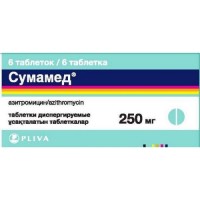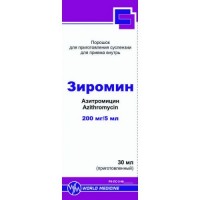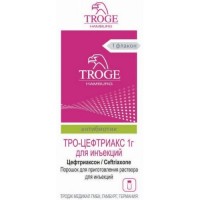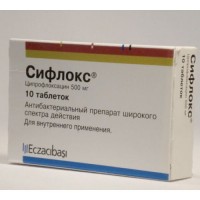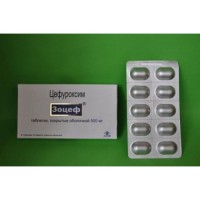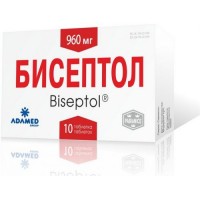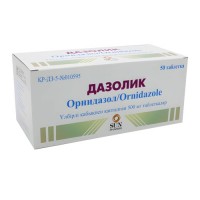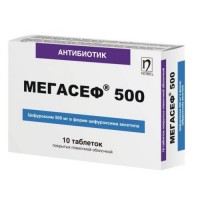Amoxicillin 500 mg (100 capsules)
- $34.30
Out Of Stock
Trade name
Amoxicillin
the International unlicensed
name Amoxicillin Dosage Form
of the Capsule of 250 mg and 500 mg
Structure
One capsule contains
active agent - amoxicillin of 250 mg and 500 mg
(in the form of trihydrate of amoxicillin of 287 mg and 574 mg),
excipients: magnesium stearate, sodium lauryl sulfate, sodium of starch glikolit,
a gelatin capsule: the water purified sodium lauryl sulfate, povidone, bronopol, gelatin,
a lid of the capsule (red-brown): blue brilliant FCF (E133), ponso 4 R (E124), titan dioxide (E171),
body of the capsule (yellow): titan dioxide (E171), yellow quinolinic (E104), ponso 4 R (E124),
pharmaceutical ink: Shellac-NF, absolute alcohol, isopropyl alcohol, butanol, propylene glycol, iron oxide black (E-172).
The description
Solid gelatin capsules, size No. 1, with the opaque body of yellow color and a lid is red - brown color. On one of sides of the capsule black ink printed AMOXI 250, inscriptions are applied on the second: the logo of the Troge Medikal GmbH company including the head of an eagle and the Troge logo (for capsules of 250 mg)
Solid gelatin capsules, size No. 0, with the opaque body of yellow color and a lid it is red - brown color. On one of sides of the capsule black ink printed AMOXI 500, inscriptions are applied on the second: the logo of the Troge Medikal GmbH company including the head of an eagle and the Troge logo (for capsules of 500 mg)
Contents of capsules the white or almost white granulated powder
Pharmacotherapeutic group
Antibacterial drugs for system use
Beta laktamnye antibacterial drugs penicillin
Penicillin of a broad spectrum of activity
Amoxicillin
the ATX J01CA04 Code
the Pharmacological
Pharmacokinetics Amoxicillin properties quickly is soaked up after oral administration. Influence of food on absorption of amoxicillin from tablets and suspension was partially studied. Amoxicillin easily gets into the majority of fabrics and liquids of an organism, except for a brain and cerebrospinal fluid, except cases when a meninx is inflamed. Elimination half-life of Amoxicillin makes 1 hour of an organism. The most part Amoksitsillina is removed in not changed view with urine, contacts proteins of blood plasma for 20%.
The maximum concentration in blood after oral administration of 250 mg and 500 mg of Amoksitsillin is observed in 1-2 hours and makes approximately 3.5mkg/ml - 5mkg/ml and 5.5mkg/ml - 7.5mkg/ml respectively. About 60% of Amoxicillin after oral administration are removed by kidneys within 6-8 hours.
A pharmacodynamics
Amoxicillin - microbicide of a broad spectrum of activity from group of semi-synthetic penicillin. Breaks synthesis of a peptidoglikan during division and growth, causes lysis of bacteria.
Amoxicillin is active concerning the following microorganisms.
Gram-positive aerobes: Streptococcus faecalis, Streptococcus pneumoniae, Streptococcus pyogenes, Streptococcus viridans, Staphylococcus aureus, Corynebacterium spp., Bacillus anthracis, Listeria monocytogenes.
Gram-negative aerobes: Haemophilus influenzae, E. coli, Proteus mirabilis, Salmonella spp., Shigella spp., Bordetella pertussis, Brucella spp., Neisseria gonorrhoeae, Neisseria meningitidis, Vibrio cholerae, Pasteurella septic.
Anaerobe bacterias: Clostridium spp.
Indications
the Infectious and inflammatory diseases caused by microorganisms, sensitive to drug:
- The ENT SPECIALIST of an infection
- an infection of an urinogenital system
- an infection of skin and soft tissues
- infections of respiratory organs
- gonorrhea and infections of urinary tract
to Apply strictly on doctor's orders!
Route of administration and doses
Inside.
Capsules of Amoxicillin accept between meals, washing down with a glass of water. The mode of dosing is selected individually taking into account weight of a course of the disease, age of the patient, a course of treatment.
Usual dose of Amoxicillin for adult 250 mg - 500 mg 3 times a day, at a heavy course of an infection on 750 mg - 1.0 g 3 times a day.
A course of treatment of 57 days, in streptococcal infections no more than 10 days.
For treatment of uncomplicated gonorrhea appoint 3.0 g of drug once (in a combination with probenetsidy).
To patients with a renal failure
the Level of glomerular filtration,
the Maximum dose
& gt, 30
Dose adjustment is not necessary to ml/minute
1030
On 500 mg 2 times a day
& lt, 10
On 500 mg a day
Side effects
Often
- dysbacteriosis, vomiting, change of taste
is rare
- fever, joint pains
- exfoliative dermatitis, a poliformny exudative erythema, a Werlhof's disease, Stephens's syndrome of Johnson, reaction similar to a serum disease
- nausea, diarrhea, stomatitis, a glossitis, a pseudomembranous coloenteritis
- an abnormal liver function, moderate increase in activity of hepatic transaminases
- excitement, uneasiness, insomnia, an ataxy, confusion of consciousness, change of behavior, a depression, peripheral neuropathy, a headache, dizziness
- a leukopenia, a neutropenia, anemia, thrombocytopenia
- the complicated breath, tachycardia, interstitial nephrite, candidiasis, superinfection (oobenno at patients with chronic diseases or the lowered resistance of an organism).
very seldom
- convulsive reactions
- an eosinophilia
in isolated cases
- an acute anaphylaxis
- urticaria, a dermahemia, an erythema, a Quincke's
disease, rhinitis,
Contraindication conjunctivitis
- digestive tract diseases in the anamnesis (especially the colitis connected with use of antibiotics)
- a lymphoid leukosis
- hypersensitivity to drug components (including to other penicillin, cephalosporins, karbapenema)
- an infectious mononucleosis
- pregnancy and the period of a lactation
- children's and teenage age up to 18 years
Medicinal interactions
Amoxicillin does not collapse in acidic environment of a stomach, meal does not influence its absorption.
Antacids, a glycosamine, laxative medicines, aminoglycosides - slow down and reduce Amoxicillin absorption, ascorbic acid increases it.
Bactericidal antibiotics (including aminoglycosides, cephalosporins, Vancomycinum, rifampicin) has sinergidny effect, bacteriostatic drugs (macroleads, chloramphenicol, linkozamida, tetracyclines, streptocides) - antagonistic.
Increases efficiency of indirect anticoagulants (suppressing intestinal microflora, reduces synthesis of vitamin K and the prothrombin ratio), reduces efficiency of estrogensoderzhashchy oral contraceptives.
Amoxicillin reduces clearance and increases toxicity of a methotrexate, strengthens digoxin absorption.
Diuretics, Allopyrinolum, oksifenbutazon, the phenylbutazone, non-steroidal anti-inflammatory drugs, drugs blocking canalicular secretion increase concentration of amoxicillin in blood.
Allopyrinolum increases risk of developing skin rash.
Special instructions
With care it is appointed in the presence of allergic diseases, hypersensitivity to penicillin, cephalosporins, karbopenema, a renal failure, bleedings in the anamnesis.
In case of long-term treatment, it is necessary to carry out periodically control of function of kidneys, a liver, blood tests. At patients with a renal failure and elderly patients removal of amoxicillin can slow down, it is necessary to be careful when prescribing drug to these groups of patients. At patients with the lowered diuresis the development of a crystalluria in this connection during administration of drug it is reasonable to accept enough liquid is possible.
During drug treatment the superinfection probability has to be considered by mycotic and bacterial pathogens. In case of the superinfection (which is usually caused by EnteroBacter, Pseudomonas and Candida), drug it is necessary to cancel and/or appoint the corresponding treatment.
During treatment false positive results when using chemical methods of definition of glucose in urine are possible.
Pregnancy and the period of a lactation
is not appointed at pregnancy and in the period of a lactation as adequate researches on use of drug in these groups were not conducted.
Features of influence of medicine on ability to run the vehicle or potentially dangerous mechanisms
Considering side effects of medicine, it is necessary to be careful when driving or potentially dangerous mechanisms.
Overdose
Symptoms: nausea, vomiting, diarrhea, disturbance of water and electrolytic balance (as a result of vomiting and diarrhea).
Treatment: gastric lavage, prescribing of activated carbon, correction of water and electrolytic balance, hemodialysis.
The form of release and packing
On 10 capsules place in blister strip packaging from a film of polyvinylchloride and aluminum foil.
On 10 planimetric packs together with the instruction for use in the state and Russian languages place in boxes of cardboard.
To Store storage conditions in the dry place, at a temperature not above 30⁰C.
To store out of children's reach!
3.5 years
not to use a period of storage after an expiration date.
To develop prescription status According to the prescription of Proizvoditel Medofarm Pvt. LTD
Amoxicillin
the International unlicensed
name Amoxicillin Dosage Form
of the Capsule of 250 mg and 500 mg
Structure
One capsule contains
active agent - amoxicillin of 250 mg and 500 mg
(in the form of trihydrate of amoxicillin of 287 mg and 574 mg),
excipients: magnesium stearate, sodium lauryl sulfate, sodium of starch glikolit,
a gelatin capsule: the water purified sodium lauryl sulfate, povidone, bronopol, gelatin,
a lid of the capsule (red-brown): blue brilliant FCF (E133), ponso 4 R (E124), titan dioxide (E171),
body of the capsule (yellow): titan dioxide (E171), yellow quinolinic (E104), ponso 4 R (E124),
pharmaceutical ink: Shellac-NF, absolute alcohol, isopropyl alcohol, butanol, propylene glycol, iron oxide black (E-172).
The description
Solid gelatin capsules, size No. 1, with the opaque body of yellow color and a lid is red - brown color. On one of sides of the capsule black ink printed AMOXI 250, inscriptions are applied on the second: the logo of the Troge Medikal GmbH company including the head of an eagle and the Troge logo (for capsules of 250 mg)
Solid gelatin capsules, size No. 0, with the opaque body of yellow color and a lid it is red - brown color. On one of sides of the capsule black ink printed AMOXI 500, inscriptions are applied on the second: the logo of the Troge Medikal GmbH company including the head of an eagle and the Troge logo (for capsules of 500 mg)
Contents of capsules the white or almost white granulated powder
Pharmacotherapeutic group
Antibacterial drugs for system use
Beta laktamnye antibacterial drugs penicillin
Penicillin of a broad spectrum of activity
Amoxicillin
the ATX J01CA04 Code
the Pharmacological
Pharmacokinetics Amoxicillin properties quickly is soaked up after oral administration. Influence of food on absorption of amoxicillin from tablets and suspension was partially studied. Amoxicillin easily gets into the majority of fabrics and liquids of an organism, except for a brain and cerebrospinal fluid, except cases when a meninx is inflamed. Elimination half-life of Amoxicillin makes 1 hour of an organism. The most part Amoksitsillina is removed in not changed view with urine, contacts proteins of blood plasma for 20%.
The maximum concentration in blood after oral administration of 250 mg and 500 mg of Amoksitsillin is observed in 1-2 hours and makes approximately 3.5mkg/ml - 5mkg/ml and 5.5mkg/ml - 7.5mkg/ml respectively. About 60% of Amoxicillin after oral administration are removed by kidneys within 6-8 hours.
A pharmacodynamics
Amoxicillin - microbicide of a broad spectrum of activity from group of semi-synthetic penicillin. Breaks synthesis of a peptidoglikan during division and growth, causes lysis of bacteria.
Amoxicillin is active concerning the following microorganisms.
Gram-positive aerobes: Streptococcus faecalis, Streptococcus pneumoniae, Streptococcus pyogenes, Streptococcus viridans, Staphylococcus aureus, Corynebacterium spp., Bacillus anthracis, Listeria monocytogenes.
Gram-negative aerobes: Haemophilus influenzae, E. coli, Proteus mirabilis, Salmonella spp., Shigella spp., Bordetella pertussis, Brucella spp., Neisseria gonorrhoeae, Neisseria meningitidis, Vibrio cholerae, Pasteurella septic.
Anaerobe bacterias: Clostridium spp.
Indications
the Infectious and inflammatory diseases caused by microorganisms, sensitive to drug:
- The ENT SPECIALIST of an infection
- an infection of an urinogenital system
- an infection of skin and soft tissues
- infections of respiratory organs
- gonorrhea and infections of urinary tract
to Apply strictly on doctor's orders!
Route of administration and doses
Inside.
Capsules of Amoxicillin accept between meals, washing down with a glass of water. The mode of dosing is selected individually taking into account weight of a course of the disease, age of the patient, a course of treatment.
Usual dose of Amoxicillin for adult 250 mg - 500 mg 3 times a day, at a heavy course of an infection on 750 mg - 1.0 g 3 times a day.
A course of treatment of 57 days, in streptococcal infections no more than 10 days.
For treatment of uncomplicated gonorrhea appoint 3.0 g of drug once (in a combination with probenetsidy).
To patients with a renal failure
the Level of glomerular filtration,
the Maximum dose
& gt, 30
Dose adjustment is not necessary to ml/minute
1030
On 500 mg 2 times a day
& lt, 10
On 500 mg a day
Side effects
Often
- dysbacteriosis, vomiting, change of taste
is rare
- fever, joint pains
- exfoliative dermatitis, a poliformny exudative erythema, a Werlhof's disease, Stephens's syndrome of Johnson, reaction similar to a serum disease
- nausea, diarrhea, stomatitis, a glossitis, a pseudomembranous coloenteritis
- an abnormal liver function, moderate increase in activity of hepatic transaminases
- excitement, uneasiness, insomnia, an ataxy, confusion of consciousness, change of behavior, a depression, peripheral neuropathy, a headache, dizziness
- a leukopenia, a neutropenia, anemia, thrombocytopenia
- the complicated breath, tachycardia, interstitial nephrite, candidiasis, superinfection (oobenno at patients with chronic diseases or the lowered resistance of an organism).
very seldom
- convulsive reactions
- an eosinophilia
in isolated cases
- an acute anaphylaxis
- urticaria, a dermahemia, an erythema, a Quincke's
disease, rhinitis,
Contraindication conjunctivitis
- digestive tract diseases in the anamnesis (especially the colitis connected with use of antibiotics)
- a lymphoid leukosis
- hypersensitivity to drug components (including to other penicillin, cephalosporins, karbapenema)
- an infectious mononucleosis
- pregnancy and the period of a lactation
- children's and teenage age up to 18 years
Medicinal interactions
Amoxicillin does not collapse in acidic environment of a stomach, meal does not influence its absorption.
Antacids, a glycosamine, laxative medicines, aminoglycosides - slow down and reduce Amoxicillin absorption, ascorbic acid increases it.
Bactericidal antibiotics (including aminoglycosides, cephalosporins, Vancomycinum, rifampicin) has sinergidny effect, bacteriostatic drugs (macroleads, chloramphenicol, linkozamida, tetracyclines, streptocides) - antagonistic.
Increases efficiency of indirect anticoagulants (suppressing intestinal microflora, reduces synthesis of vitamin K and the prothrombin ratio), reduces efficiency of estrogensoderzhashchy oral contraceptives.
Amoxicillin reduces clearance and increases toxicity of a methotrexate, strengthens digoxin absorption.
Diuretics, Allopyrinolum, oksifenbutazon, the phenylbutazone, non-steroidal anti-inflammatory drugs, drugs blocking canalicular secretion increase concentration of amoxicillin in blood.
Allopyrinolum increases risk of developing skin rash.
Special instructions
With care it is appointed in the presence of allergic diseases, hypersensitivity to penicillin, cephalosporins, karbopenema, a renal failure, bleedings in the anamnesis.
In case of long-term treatment, it is necessary to carry out periodically control of function of kidneys, a liver, blood tests. At patients with a renal failure and elderly patients removal of amoxicillin can slow down, it is necessary to be careful when prescribing drug to these groups of patients. At patients with the lowered diuresis the development of a crystalluria in this connection during administration of drug it is reasonable to accept enough liquid is possible.
During drug treatment the superinfection probability has to be considered by mycotic and bacterial pathogens. In case of the superinfection (which is usually caused by EnteroBacter, Pseudomonas and Candida), drug it is necessary to cancel and/or appoint the corresponding treatment.
During treatment false positive results when using chemical methods of definition of glucose in urine are possible.
Pregnancy and the period of a lactation
is not appointed at pregnancy and in the period of a lactation as adequate researches on use of drug in these groups were not conducted.
Features of influence of medicine on ability to run the vehicle or potentially dangerous mechanisms
Considering side effects of medicine, it is necessary to be careful when driving or potentially dangerous mechanisms.
Overdose
Symptoms: nausea, vomiting, diarrhea, disturbance of water and electrolytic balance (as a result of vomiting and diarrhea).
Treatment: gastric lavage, prescribing of activated carbon, correction of water and electrolytic balance, hemodialysis.
The form of release and packing
On 10 capsules place in blister strip packaging from a film of polyvinylchloride and aluminum foil.
On 10 planimetric packs together with the instruction for use in the state and Russian languages place in boxes of cardboard.
To Store storage conditions in the dry place, at a temperature not above 30⁰C.
To store out of children's reach!
3.5 years
not to use a period of storage after an expiration date.
To develop prescription status According to the prescription of Proizvoditel Medofarm Pvt. LTD

